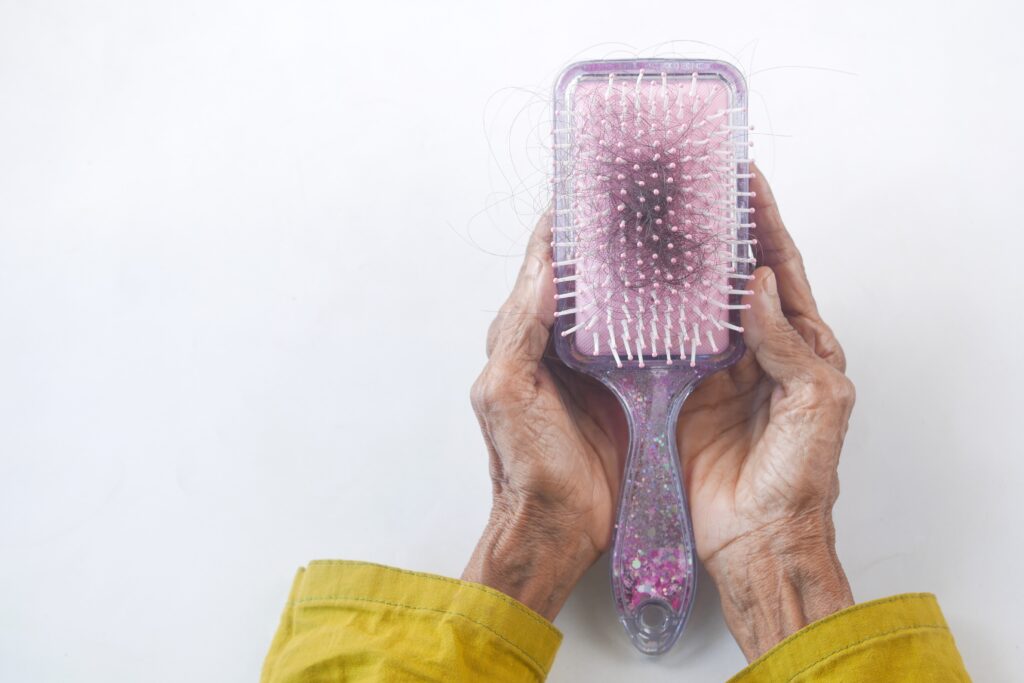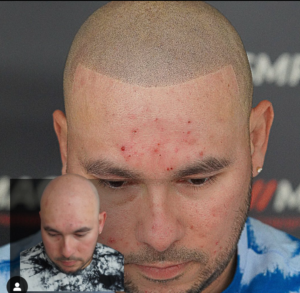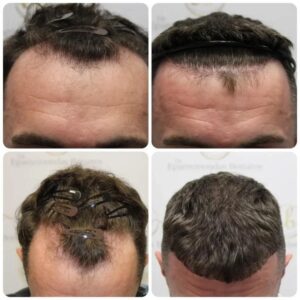If you’re experiencing hair loss, you’re not alone. Alopecia is a common condition that can cause hair loss on the scalp, face, and body. While there’s currently no cure for alopecia, there are some alopecia treatments available that can slow or stop hair loss and even regrow lost hair.
This guide will cover the different types of alopecia, the available treatments, and how to choose the right treatment for you.
Ready to get started? Let’s dive in.

Table of Contents
Key Takeaway
Many treatments for alopecia are available, but not all are effective for everyone. Some people might need to try several treatments before finding the one that works best for them.
Some of the most effective treatments for alopecia include:
- Topical creams
- Oral medications
- Injections
- Light therapy
What is alopecia?
Before we look at the available alopecia treatments, let’s look at the concept itself. Alopecia areata is an autoimmune disorder that causes hair loss. For people with alopecia areata, treatments aim to address the immune system attack on hair follicles.
Several treatments are available for alopecia, including topical creams, oral medications, injections, and light therapy. Some treatments are more effective than others, and some may work better for certain types of alopecia.
Alopecia can affect both men and women and can occur at any age. See a doctor if you are experiencing hair loss, as there might be an underlying medical condition that needs to be treated.
Causes of Alopecia: Understanding the Triggers Behind Hair Loss
Understanding the underlying causes contributing to various alopecia forms is crucial to address this issue effectively. While the exact mechanisms may vary, several factors are known to trigger hair loss. Here are some of the primary causes of alopecia:
1. Genetics and Family History:
One of the most significant factors contributing to alopecia is genetics. Your risk of developing alopecia increases if you have a family history of hair loss, particularly in immediate family members. This hereditary pattern is common in conditions like male and female baldness.
2. Hormonal Imbalances:
Hormones can significantly impact hair growth and loss. Conditions such as polycystic ovary syndrome (PCOS), thyroid disorders, and hormonal changes during pregnancy or menopause can lead to temporary or permanent hair loss.
3. Autoimmune Disorders:
Certain autoimmune diseases, like alopecia areata, cause the immune system to mistakenly attack hair follicles, leading to sudden patchy hair loss on the scalp or other body parts.
4. Stress and Emotional Factors:
Stress is a known trigger for hair loss. Prolonged periods of stress can disrupt the normal hair growth cycle, leading to excessive shedding or even hair loss disorders like telogen effluvium.
5. Medical Conditions and Treatments:
Underlying medical conditions like scalp infections, skin disorders (e.g., psoriasis), or cancer treatments such as chemotherapy can result in hair loss as a side effect.
6. Nutritional Deficiencies:
Inadequate intake of essential nutrients, particularly vitamins, and minerals like iron, biotin, and zinc, can impact hair health and contribute to alopecia.
7. Hairstyling and Practices:
Excessive use of hairstyling tools, tight hairstyles (like braids or ponytails), and chemical treatments can damage hair and potentially lead to traction alopecia.
8. Age:
As people age, the rate of hair growth may slow down, and hair follicles may become more sensitive to hormonal changes, resulting in age-related hair loss.
Understanding these causes is crucial for selecting the most appropriate treatment and management strategies for different types of alopecia.

How is alopecia diagnosed?
There’s no single test for alopecia, but your doctor might be able to diagnose it based on a physical examination and your answers to a few questions. If your hair loss is patchy, your doctor will look for causes such as fungi or other infections.
If your hair loss is more widespread, your doctor will order blood tests to look for autoimmune diseases that can cause alopecia, such as lupus or thyroid disease.
A scalp biopsy may also be performed to rule out other conditions, but alopecia is often diagnosed simply by looking at your hair and observing the pattern of hair loss.
What are the different types of alopecia? Recognizing the Diverse Forms of Hair Loss
Alopecia is a catch-all term for hair loss. Just like there are different types of alopecia treatments, there are also several types of alopecia, each with its symptoms and causes.
Some of the most common types of alopecia include:
1. Alopecia areata:
Alopecia areata is the most common form of alopecia, and it causes patchy hair loss. It is believed to be an autoimmune disease in which the body’s immune system mistakenly attacks the hair follicles.
2. Alopecia totalis:
Alopecia totalis is a condition that causes complete hair loss on the scalp. This can happen due to damage of the hair follicles, or it may be due to a genetic predisposition. In most cases alopecia totalis affects only the scalp, but in rare instances it can also lead to a complete loss of body hair.
3. Alopecia universalis:
Alopecia universalis is a rare form of alopecia that leads to complete hair loss on the scalp and the body.
4. Androgenic alopecia:
Androgenic alopecia is more commonly known as male pattern baldness. It’s the most common form of alopecia, affecting about 50 million men in the United States. It is characterized by a receding hairline and thinning hair on the crown of the head.
5. Telogen effluvium:
Telogen effluvium is a type of alopecia caused by physical or psychological stress. It results in thinning hair all over the scalp, but it is often temporary.
6. Anagen effluvium:
Anagen effluvium is another alopecia type caused by certain medications such as chemotherapy drugs. It results in the loss of hair all over the scalp, and it too is often temporary.
7. Traction Alopecia:
This type of hair loss results from prolonged tension on the hair follicles due to tight hairstyles, hair extensions, or other hairstyling practices.
8. Scarring Alopecia:
This type of alopecia is characterized by the destruction of hair follicles and their replacement with scar tissue. It can result from various skin conditions and inflammatory disorders.
9. Involutional Alopecia:
A natural part of the aging process, involutional alopecia involves gradual hair thinning and increased resting (telogen) phase of the hair cycle.
What are the available treatments for alopecia?
Several treatments can help to slow hair loss and promote hair growth. Some of the most common treatments for alopecia include:
1. Hair transplantation:
Hair transplantation is a surgical procedure where healthy hair follicles are taken from a donor site and transplanted to areas experiencing hair loss. It offers a long-term solution for male and female pattern baldness or some instances of scarring alopecia.
The two primary methods are Follicular Unit Transplantation (FUT) and Follicular Unit Extraction (FUE). The transplanted hair grows naturally, providing permanent results. Consulting with an experienced surgeon is essential to determine candidacy and achieve natural-looking outcomes.
2. Minoxidil (Rogaine):
Minoxidil is a topical medication that is commonly used to promote hair growth. When applied to the scalp, it helps improve blood flow to hair follicles, potentially extending the growth phase of hair and increasing its thickness and density.
Minoxidil is available over the counter and is suitable for men and women experiencing androgenetic alopecia. Regular and consistent use is essential to maintain the results, and it may take several months before noticeable improvements are seen.
3. Finasteride (Propecia):
Finasteride is an oral medication to slow down hair loss in men with androgenetic alopecia. It works by inhibiting the production of dihydrotestosterone (DHT), which significantly contributes to male pattern baldness.
By reducing DHT levels, finasteride can help preserve hair follicles and prevent further hair loss. It is most effective for the crown and mid-scalp areas in men. However, it is not recommended for women and may have potential side effects, including sexual dysfunction, which should be discussed with a healthcare provider.
4. Diphencyprone (DCP):
Diphencyprone is a topical medication used to treat alopecia areata, an autoimmune form of hair loss. When applied to the affected areas of the scalp, DCP triggers a localized allergic reaction, which aims to suppress the immune response attacking the hair follicles.
This treatment may induce hair regrowth, but it requires careful application and monitoring by a dermatologist due to potential side effects and the need for precise dosing.
5. Corticosteroids:
Corticosteroids are anti-inflammatory medications commonly used to treat alopecia areata. They can be applied topically, injected into the affected areas, or taken orally, depending on the severity of the condition.
Corticosteroids help reduce inflammation and suppress the immune response that attacks hair follicles. While they can effectively promote hair regrowth, long-term or excessive use may have side effects, such as thinning of the skin and potential systemic effects, so they are typically used in controlled and limited doses.
6. Laser Therapy:
Low-level laser therapy (LLLT) is a non-invasive treatment being researched for its potential to stimulate hair growth and improve hair density. LLLT devices emit red or near-infrared light, which is believed to increase blood flow to the scalp and promote cell metabolism in hair follicles.
While it shows promise, more research is needed to establish its effectiveness fully. LLLT is generally considered safe and is often used with other hair loss treatments.

Latest Research on Alopecia Treatments: Advancements and Breakthroughs
Researchers and medical professionals continue to explore innovative approaches to treat alopecia, aiming to provide more effective and long-lasting solutions for those affected. Some of the latest research on alopecia treatments includes:
1. Stem Cell Therapy:
Stem cell research holds promise for hair regrowth. Scientists are investigating ways to stimulate dormant hair follicles and regenerate hair using stem cells.
2. Platelet-Rich Plasma (PRP) Therapy:
PRP therapy involves injecting concentrated platelets from the patient’s blood into the scalp to promote hair growth and stimulate follicles.
3. Immunotherapy:
For alopecia areata, researchers are exploring immunotherapy drugs to modify the immune response and prevent the attack on hair follicles. Read this article for a detailed insight into hair regrowth after chemo.
4. Gene Therapy:
Gene-based treatments are being studied to correct genetic defects responsible for certain types of alopecia, offering a potential cure.
5. Nutraceuticals and Supplements:
Studies are being conducted to explore the effectiveness of specific vitamins, minerals, and herbal supplements in promoting hair growth and preventing hair loss.
6. Topical JAK Inhibitors:
Janus kinase (JAK) inhibitors are being investigated as topical solutions to treat alopecia areata by blocking the immune response that attacks hair follicles.
Baricitinib (Olumiant) and Ritelcitinib (LITFULO) are oral JAK inhibitors that FDA (food and drug administration) has approved to treat alopecia areata, an autoimmune condition causing hair loss.
Baricitinib, initially approved for rheumatoid arthritis, has demonstrated encouraging results in promoting hair regrowth in clinical trials for moderate to severe alopecia areata cases. It is often used for patients who haven’t responded well to other treatments or have extensive hair loss. However, it may have side effects like increased infection risk and liver enzyme elevations, requiring close monitoring.
Ritelcitinib is another JAK inhibitor undergoing clinical trials. Early data suggests it may effectively promote hair regrowth and improve alopecia areata. If approved, it could offer an alternative treatment for non-responsive patients. Its safety profile is still being assessed, so patients should discuss potential risks and benefits with their healthcare provider before considering it.
While some of these treatments are already available or in clinical trials, others are still in the early stages of research. It’s essential to consult with a healthcare professional to determine the most suitable treatment based on individual circumstances and the type of alopecia experienced. As research progresses, the future looks promising for more advanced and personalized alopecia treatments.
How do you choose the proper treatment for alopecia?
Several things should be considered when choosing a treatment for alopecia.
First, you should consider the type of alopecia that you have. There are different types of alopecia, and each type may respond better to specific treatments.
Second, you should consider the severity of your hair loss. If you only have mild hair loss you might just need a topical cream or oral medication, but severe hair loss might call for a more aggressive treatment such as injections or light therapy.
Finally, consider your personal preferences. Some people prefer less invasive treatments such as creams or pills, while others might be willing to try more aggressive treatments such as injections or light therapy. Talk to your doctor about all your options so that you can make the best decision for yourself.
What are the risks and side effects of alopecia treatments?
There are a few risks and side effects associated with alopecia treatments. Topical creams can cause skin irritation, while oral medications can occasionally cause stomach upset. Injections can be painful and cause swelling at the injection site.
Light therapy can cause redness and irritation of the skin. Be sure to seek your doctor’s opinion about the risks and side effects of each treatment so that you can make an informed decision about which treatment is right for you.
Conclusion
We have reviewed some alopecia treatments that can help slow or even stop its progression. These treatments include topical creams, oral medications, injections, and light therapy.
Some treatments are more effective than others, and some may work better for certain types of alopecia. The best treatment for alopecia will ultimately be determined on an individual basis by a qualified medical professional.
If you are experiencing hair loss, you should consult your doctor to determine the underlying cause and discuss your treatment options. With the right treatment plan, you may be able to slow your hair loss, prevent additional hair loss, and even regrow lost hair.




